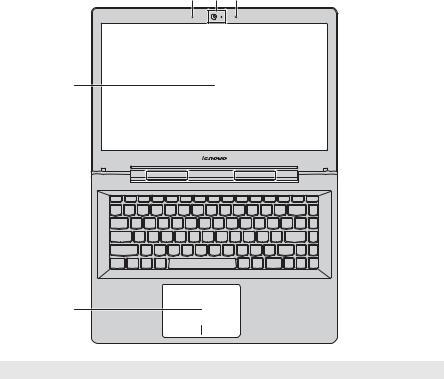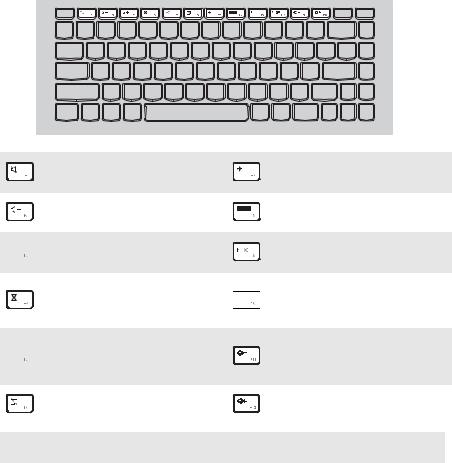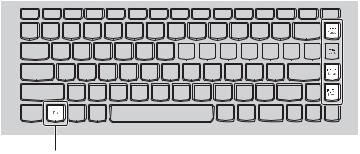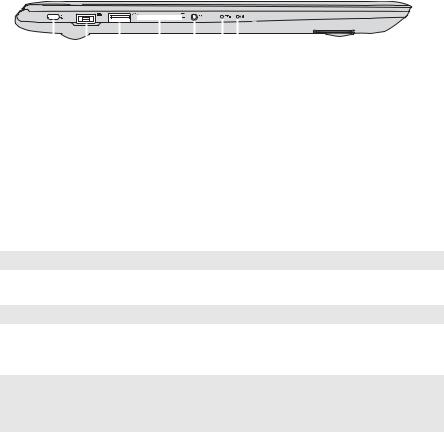Lenovo U41-70, S41-75, S41-70, S41-35 User Manual

Lenovo S41/U41
S41-35
S41-70
S41-75
U41-70
User Guide
lmn
Read the safety notices and important tips in the included manuals before using your computer.

Notes
•Before using the product, be sure to read Lenovo Safety and General Information Guide first.
•Some instructions in this guide may assume that you are using Windows® 8.1. If you are using another Windows operating system, some operations may be slightly different. If you are using other operating systems, some operations may not apply to you.
•The features described in this guide are common to most models. Some features may not be available on your computer or your computer may include features that are not described in this user guide.
•The illustrations used in this manual are from Lenovo S41 unless otherwise stated.
•The illustrations in this manual may differ from the actual product. Please refer to the actual product.
Regulatory Notice
• For details, refer to Guides & Manuals at http://support.lenovo.com.
First Edition (January 2015)
© Copyright Lenovo 2015.
LIMITED AND RESTRICTED RIGHTS NOTICE: If data or software is delivered pursuant to a General Services Administration “GSA” contract, use, reproduction, or disclosure is subject to restrictions set forth in Contract No. GS-35F-05925.
Contents
Chapter 1. Getting to know your computer ......................................... |
1 |
Top view ...................................................................................................................... |
1 |
Left-side view ............................................................................................................. |
5 |
Right-side view ........................................................................................................... |
9 |
Bottom view .............................................................................................................. |
10 |
Chapter 2. Starting to use Windows 8.1 ............................................ |
11 |
Configuring the operating system for the first time ........................................... |
11 |
Operating system interfaces ................................................................................... |
11 |
The charms ................................................................................................................ |
12 |
Putting the computer to sleep or shutting it down ............................................. |
15 |
Connecting to a wireless network ......................................................................... |
18 |
Help and support ..................................................................................................... |
19 |
Chapter 3. Lenovo OneKey Recovery system .................................. |
20 |
Chapter 4. Troubleshooting ................................................................ |
22 |
Frequently asked questions .................................................................................... |
22 |
Troubleshooting ....................................................................................................... |
25 |
Trademarks ........................................................................................... |
28 |
i

Chapter 1. Getting to know your computer
 Top view ---------------------------------------------------------------------------------------------------
Top view ---------------------------------------------------------------------------------------------------
b a b
c
d
 e
e
f
Note: The dashed areas indicate parts that are not visible externally.
Attention:
•Do not open the display panel beyond 180 degrees. When closing the display panel, be careful not to leave pens or any other objects in between the display panel and the keyboard. Otherwise, the display panel may be damaged.
1

Chapter 1. Getting to know your computer
aIntegrated camera (on select models)
bBuilt-in microphones
cComputer display
dWireless LAN antennas
ePower button
fTouch pad
Use the camera for video communication.
Capture sound which can be used for video conferencing, voice narration, or audio recording.
The LCD display with LED backlight provides brilliant visual output.
Connect to a wireless LAN adapter to send and receive wireless radio signals.
Press this button to turn on the computer.
The touch pad functions as a conventional mouse.
Touch pad: To move the pointer on the screen, slide your fingertip over the pad in the direction in which you want the pointer to move.
Touch pad buttons: The functions of the left/right side correspond to those of the left/right mouse button on a conventional mouse.
Note: You can enable/disable the touch pad by pressing F6 ( ).
).
2

Chapter 1. Getting to know your computer
Using the keyboard
Hotkeys
You can access certain system settings quickly by pressing the appropriate hotkeys.
Mutes/unmutes the : sound.
Decreases the volume : level.
 : Increases the volume level.
: Increases the volume level.
Closes the currently active : window.
Refreshes the desktop or  : the currently active
: the currently active
window.
Enables/disables the touch : pad.
Enables/disables Airplane : mode.
Displays all currently : active apps.
Turns on/off the backlight : of the LCD screen.
Toggles the display
 : between the computer and an external device.
: between the computer and an external device.
Decreases display : brightness.
Increases display : brightness.
Note: If you changed the Hotkey Mode from Enabled to Disabled in the BIOS setup utility, you will need to press the Fn key in combination with the appropriate hotkey.
3

Chapter 1. Getting to know your computer
Function key combinations
Through the use of the function keys, you can change operational features instantly. To use this function, press and hold Fn a; then press one of the function keys b.





 b
b
a
The following describes the features of each function key.
Fn + Home: |
Activate the pause function. |
|
|
Fn + End: |
Activate the break function. |
|
|
Fn + PgUp: |
Enable/Disable the scroll lock. |
|
|
Fn + PgDn: |
Activate the insert function. |
4

Chapter 1. Getting to know your computer
 Left-side view --------------------------------------------------------------------------------------
Left-side view --------------------------------------------------------------------------------------
|
|
|
|
|
|
|
|
|
|
|
|
|
|
|
|
|
|
|
|
|
|
|
|
|
|
|
|
|
|
|
|
|
|
|
|
|
|
|
|
|
|
|
|
|
a b c |
|
d e fg |
||||||||||||
a Kensington slot |
Attach a security lock (not supplied) here to help protect |
|||||||||||||
|
|
|
|
|
|
your computer from theft and unauthorized use. |
||||||||
|
|
|
|
|
|
You can attach a security lock to your computer to help |
||||||||
prevent it from being removed without your permission. For details on installing the security lock, please refer to the instructions shipped with the security lock that you have purchased.
bAC power adapter Connects to the AC power adapter. jack
c USB 2.0 port |
Connects to USB devices. |
Note: For details, see “Connecting USB devices” on page 7.
d Memory card slot Insert memory cards (not supplied) here.
Note: For details, see “Using memory cards (not supplied)” on page 8.
e Combo audio |
Connects to headsets. |
jack |
|
Notes:
•The combo audio jack does not support conventional microphones.
•The recording function may not be supported if third-party headphones or headsets are connected, due to different industry standards.
5
Chapter 1. Getting to know your computer
fBattery status indicator
gPower status indicator
Indicator |
Indicator status |
Meaning |
|
|
|
|
On (solid white) |
The battery has more than 20% charge. |
|
|
|
|
Solid amber |
The battery has between 5% and 20% |
|
|
charge. |
|
|
|
|
Fast blinking amber |
The battery has less than 5% charge. |
Battery |
|
|
Slow blinking amber |
The battery is being charged. When |
|
status |
|
battery charge reaches 20%, the blinking |
indicator |
|
color changes to white. |
|
Slow blinking white |
The battery has between 20% and 80% |
|
|
charge and is still charging. When the |
|
|
battery reaches 80% charge the light will |
|
|
stop blinking, but charging will continue |
|
|
until the battery is fully charged. |
|
|
|
Power status |
On (solid white) |
The computer is powered on. |
|
|
|
Blinking |
The computer is in sleep mode. |
|
indicator |
|
|
|
Off |
The computer is powered off. |
|
|
|
6

Chapter 1. Getting to know your computer
Connecting USB devices
You can connect a USB device to your computer by inserting its USB plug (Type A) into the USB port on your computer.
The first time you plug a USB device into a particular USB port on your computer, Windows automatically installs a driver for that device. After the driver has been installed, you can disconnect and reconnect the device without performing any additional steps.
Note: Typically, Windows detects a new device after it has been connected, and then installs the driver automatically. However, some devices may require you to install the driver before connecting. Check the documentation provided by the device’s manufacturer before connecting the device.
Before disconnecting a USB storage device, make sure your computer has finished transferring data to that device. Click the Safely Remove Hardware and Eject Media icon in the Windows notification area to remove the device before disconnecting.
Note: If your USB device uses a power cord, connect the device to a power source before connecting it. Otherwise, the device may not be recognized.
7
